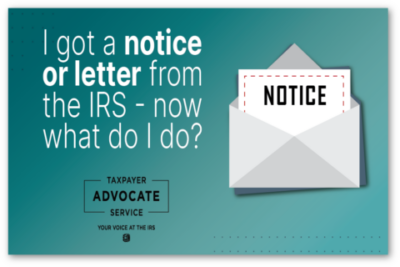

The IRS will send a notice or a letter for any number of reasons, including:
You can handle most of this correspondence without calling, visiting an IRS office, or involving the Taxpayer Advocate Service (TAS) by following the instructions in the notice or letter.
However, sometimes these letters or notices can be confusing and hard to understand. Here are some tips to help you when you receive a notice or letter from the IRS.
Your notice or letter will explain the reason for the contact and give you instructions on how to handle the issue. If you need help understanding the information provided, the IRS has a Search Notice and Letters feature on the Understanding Your IRS Notice or Letter page. TAS also has a tool called the Taxpayer Roadmap, which includes copies of common letters and notices that you can use.
You can find the notice (CP) or letter (LTR) number on either the top or the bottom right-hand corner of your correspondence. Once you find it, you can enter that number in the search feature and you will be taken to a corresponding page that has more general information that may help.
The Taxpayer Advocate Service has a GET HELP section on various topics that can lead you through important information and steps and actions necessary to help you resolve many common tax issues.
Whether you need to reply or not will depend on the issue.
If you agree with the information or change listed on the notice or letter, generally there is no need to reply. If the action causes a balance due, then you should take action immediately. Other times, even if you do agree, you may need to provide specific information to resolve the issue, particularly if you need to verify your identity.
If you disagree, you will need to act as soon as possible, as penalties and interest may be accruing, depending on the circumstances. The letter should outline what that action is and include a due date for your response.
Whether you agree or not, if it requires a reply – do not delay! Delaying can create more issues. See more on this below.
If your notice or letter requires a response by a specific date, there are many reasons you’ll want to comply. Here are just a few:
If you need more time to respond than the notice or letter indicates, contact the IRS using the contact information included on the notice or letter or call the general number, shown below, but only if a specific contact is not indicated.
All notices and letters should tell you where to send your response, whether it’s to a mailing address or fax number. (Note: The IRS generally does not allow communication via email yet, although they are currently working on developing some alternative digital communication options.)
Follow the instructions in your notice or letter. See the IRS Operational status page for IRS customer service timeframes and updates as there are still some delays due to the ongoing pandemic.
Each notice or letter should include contact information. Some phone numbers on notices or letters are general IRS toll-free numbers, but if a specific employee is working your case, it will show a specific phone number to reach that employee or the department manager. The telephone number is usually found in the upper right-hand corner of your notice or letter.
As a last resort, you can use the IRS toll-free number at 800-829-1040. Have a copy of your tax return and the correspondence available when you call. But your best option is to use the specific number or address provided.
You can resolve most notices or letters without help, but you can also get the help of a professional – either the person who prepared your return, or another tax professional.
If you can’t afford to hire a tax professional to assist you, you may be eligible for free or low cost representation from an attorney, certified public accountant, or enrolled agent associated with a Low Income Taxpayer Clinic (LITC). In addition, LITCs can help if you speak English as a second language and need help understanding the notice or letter. For more information or to find an LITC near you, see the LITC page at www.taxpayeradvocate.irs.gov/litcmap or IRS Publication 4134, Low Income Taxpayer Clinic List.
If your IRS problem is causing you financial hardship, and you’ve tried repeatedly or aren’t receiving a response from the IRS, or you feel your taxpayer rights are not being protected, see Can TAS help me with my tax issue?.